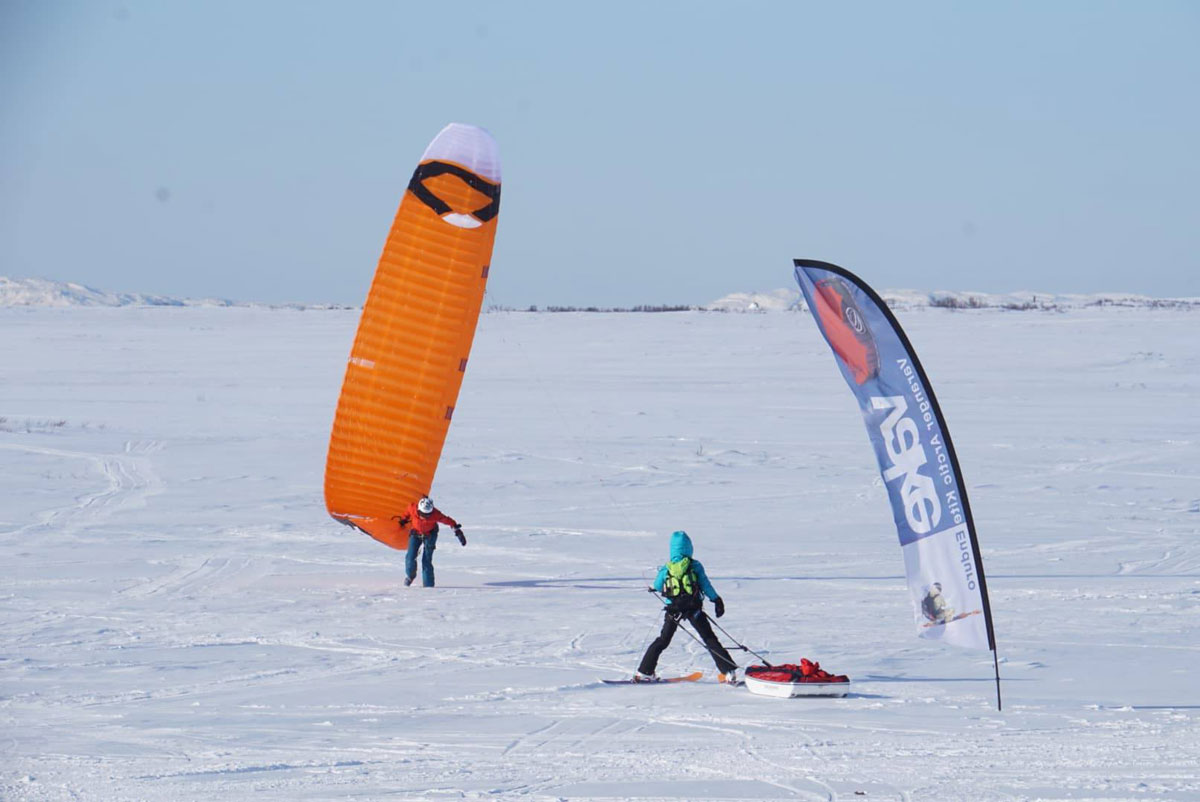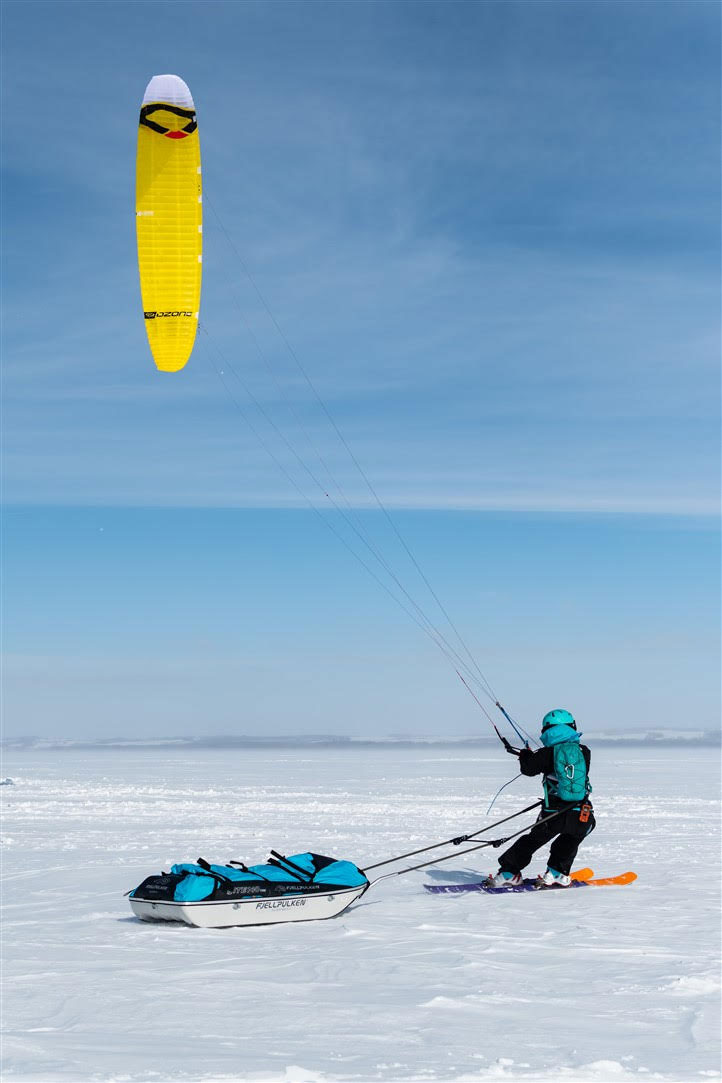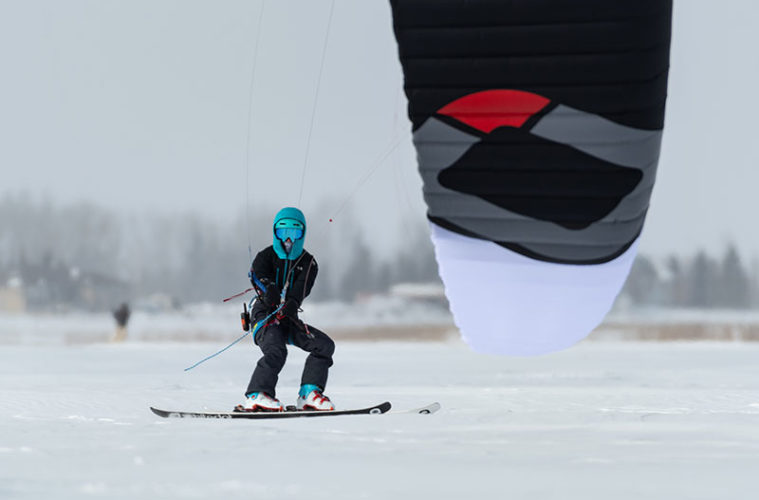Canadian Marie-Eve Mayrand is no stranger to kiting in turbulent conditions in remote landscapes. She has won gold, silver and bronze at the Red Bull Ragnarok in three successive years. This year, she took on a weightier challenge with Varanger Arctic Kite Enduro 2019 (VAKE) an extreme test of endurance and skill in the northern recesses of the world.
The VAKE long kiting WISSA World Championship ran from April 2-7 in Finnmark, Norway, drawing 35 teams from 12 countries including Canada, Czech Republic, Denmark, Finland, France, Germany, Norway, Romania, Russia, Slovakia, Sweden and Switzerland. There were three all-female teams, five mixed teams, four family teams, new teams and teams with a new member. VAKE has a 250-kilometre course to be covered in 4 ½ days with a daily sailing window from 7 am to 9 pm and overnight winter camping in the Arctic Circle. Marie-Eve teamed up with Frøydis Sjøvold, a four-time participant at VAKE and recounts her experience as a first-time participant at VAKE.

Photo: Marit Helen Pederen
Day 1: Launching from Berlevåg
The competitors took the bus on a scenic route from Vadsø to Berlevåg, where they would meet the other teams and reunite with old friends from the kiting circuit. The common passion for this sport makes snowkiters a close-knit community.
“People come back every year as it is such an exciting event and gathering of snowkiting enthusiasts. We had two nights and one full day in the sports hall to get ready, go through the weight station, have the riders’ meeting, and relax a little before the race,” Marie-Eve says.
On race morning, BerlevÃ¥g locals gathered in the streets to cheer on the competitors. Racers have a kilometer’s uphill walk (ski touring) before they are allowed to launch their kites. The morning was windy but the forecast called for dying wind in the afternoon. So everyone was eager to take advantage of the morning wind to cover as much distance as possible using bigger kite sizes. Marie-Eve and Frøydis opted to start with mid-sized kites, with the latter on her 9m Ozone R1V3.

Photo: Marit Helene Pederen
Light winds and checkpoint one at Sternevann
Soon after, they were hindered by light winds. As Marie-Eve packed her kite to start walking uphill, some teams struggled ahead of them by keeping their kites up. The slowing winds continued to bother them through the Storkløftfjellet waypoints till they reached the first manned checkpoint, Sternevann, at 6:31 pm for a mandatory 2-hour rest. The stop was revitalizing and they also met the other teams closest to them. They recommenced the race with 29 minutes left in the day. They covered some distance on foot and then set up tent for their first night in the Arctic open, eating dry food, heating up water, and hoping to catch the northern lights.

Photo: Saga Svavarsdottir
Day 2: Whiteouts and frozen lines
Marie-Eve and Frøydis had to walk for about 6-7 kilometers before being able to launch their 13m and 15m kites. The light wind slowed their progress and it took them almost half a day to get to Mattavarri checkpoint. The day also brought a complete whiteout in that area with very low visibility and contrast. “I had to stay very close to my teammate as we could not even see each other! The humidity of the whiteout froze my bridles and I had to stop to remove the ice several times,” Marie-Eve remembers. They engaged in stiff competition with the other all-female duo Team Camillia as they gained and lost ground on each other. During the whiteout, Team Camillia passed them. “It was tough going. There was significant upwind distance to cover, and at times, I thought my knees would give up,” Marie-Eve recollects. Marie-Eve and Frøydis managed to do five more waypoints by the end of the day, including a mandatory stop at Jakobselva.

Photo: Marit Helen Pederen
Day 3: In a bind at Komagær
Lighter winds in the morning guided their choice of their 13m kites. However, on a downhill part, Marie-Eve’s sled flipped over as she was going too fast. “We also had to make it through the waypoint called Sh#$wood!” Marie-Eve chuckles. An appropriate name, considering the very tall trees which posed significant difficulty for some teams, especially with lighter winds. But they had a stroke of luck with a good wind aiding them to cover the area quickly and reach the last mandatory 2-hour rest at the Vadsø checkpoint.
Here, they changed to smaller kites to take advantage of the wind which had picked up quite a bit. They arrived at Falkefjell placed second among all-female teams and 13th overall. From here, they had to cross the valley towards Komagær — one of the most challenging terrains to navigate. In Komagær, they lost a lot of time because of trouble with Marie-Eve’s kite bridles. Some teams passed them while she diagnosed the problem, which turned out to be cut bridles forcing her to switch to her 9m kites to get going. “By this time, we had little chance of overtaking the other all-female team. Our only hope was to reach the finish line before 9 pm, failing which we would have to spend another night in the open. Another whiteout in the darkening hours with light winds stalled our progress in the final phase, but we were excited to cross the finish line at 8:23 pm on day 3 of the competition!” Marie-Eve explains. While VAKE has no podium category for women or mixed-teams, Marie-Eve and Frøydis finished second among the all-female teams and 17th overall. “This was a tremendous accomplishment for a first-timer like me with a new team,” Marie-Eve says excitedly.

Photo: Saga Svavarsdottir
An impressive field
Marie-Eve notes a high caliber of kiters equipped with the latest gear, who are getting better and stronger compared to past years when many teams did not manage to finish the race. She found the Czech team, Navrhuju snist psy, particularly impressive. More women are participating in these endurance races, competing with male teams. The Race kite was quite popular among the participants.
In retrospect

Photo: Aymeric Pierrat
Marie-Eve found it a fantastic experience to kite in such a “breathtaking landscape with priceless views of the sea and the national park”. She says she has learned a lot and emerged a better kiter. “One of the hardest decisions for VAKE was choosing the right kites to pack. They add to the weight of the sled, so it is important to choose strategically while staying light. This was difficult as I was so used to having all sizes of kite on hand. But ultimately, this was a test of skills, navigation, teamwork, and problem-solving,” she observes.
On the course, kites got caught in trees and blew off-track, kite bridles froze and got cut, and sleds fell into canyons and creeks. Fortunately, no one was injured at this year’s edition. New laws related to the national park home of the polar fox proved challenging for the VAKE organization. Certain areas were restricted, and the race had to be rerouted closer to the side shore. Marie-Eve kudos to them for maneuvering the legal requirements to still put up a great race. She was also impressed by the meticulous organization, careful planning, and VAKE’s zero-waste policy which would disqualify competitors if they dropped or lost anything during the race.
A gracious participant, Marie-Eve is all praise for the winners: “I want to congratulate all the winners, particularly my Ozone teammates from Navrhuju snist psy for their first position, Jonas and Florien who won second place, and the Beckett Brothers.” She also thanks Ozone Kites, Mystic Boarding and Fjellpulken for supporting her on the snowkiting circuit this year. “The hot tub party and celebration dinner were elaborate in true Norwegian style. That was fun and relaxing after the tough race,” she says.
As for future plans, Marie-Eve hopes to return “stronger and wiser to VAKE next year”, to what she considers “the most beautiful and challenging terrain” she has ever ridden in. And when she does, she hopes to see more women taking up the challenge.


